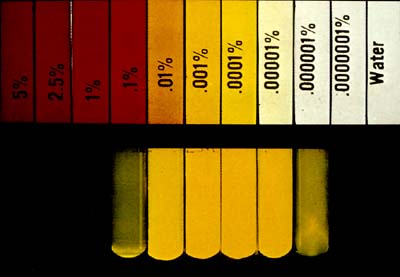The Sodium Fluorescein Technique:
Dye concentration
One critical factor in the photography of sodium fluorescein is concentration of the dye (Hodge, 1978). Concentrations stronger than 0.1%, or weaker than 0.0000001%, do not fluoresce (Figure 44); maximum fluorescence occurs at 0.00001%, so care should be taken in administering the dye to obtain optimum dye concentration and, therefore, best photographic results. The absence of fluorescence is not necessarily an indication to increase the dose of sodium fluorescein because the dye may already be too concentrated; some ill-informed workers go on increasing the dosage puzzled at the lack of results (Figure 45).

Figure 44 (above). A series of different concentrations of sodium fluorescein stimulated at 450nm. It can be seen that concentrations stronger than 0.1%, or weaker than 0.0000001%, do not fluoresce.

Figure 45 (above). Ok it's a Joke! Emphasizing the fact that no fluorescence does not necessarily mean that the dose of sodium fluorescein needs to be increased.
References
- Hodge, C., 1978, "Fluorescein angiography of the brain - the photographic procedure," J. Biol. Photogr. 46(2):67- 79.
|


![]() Home > Articles > Fluorescence Photography > Sodium Fluorescein Technique: Dye concentration
Home > Articles > Fluorescence Photography > Sodium Fluorescein Technique: Dye concentration